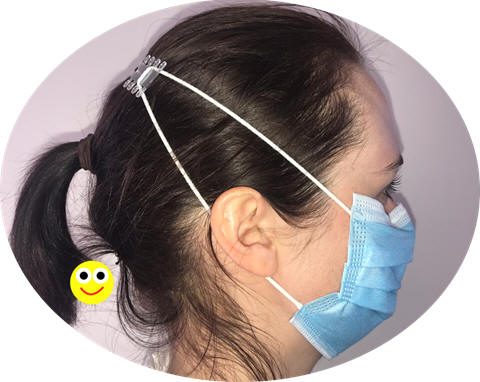
CATER Mask
Decisions
February 4, 2021
Three Step Mask Program Tomorrow will Show that
Masks are the Best Weapon to Combat COVID
Mask Efficiency will be as Important as Vaccine
Efficacy
Masks can be Made Available More Quickly Than
Vaccines
Important Findings on Mask use by PatientKnowhow
Two Percent Gap Can Cause Fifty Percent of the
Air to Circumvent the Media
Comfort Clip Designed to Provide Optimal Mask
Fit
______________________________________________________________________________
Three Step Mask Program Tomorrow will Show that
Masks are the Best Weapon to Combat COVID
The webinar will provide further evidence that
tight fitting efficient masks will save many
thousands of lives. But it takes coordination of
suppliers, researchers, and governmental
organizations to make this happen.
The three steps are (l) launching an awareness
blitz, (2) advise on which masks should be worn
and (3) prioritize masks for the vulnerable.
The three steps are described in detail
in previous Alerts.
January 27 - Description of the three step mask
program
January 28 - Outline of the three steps
February 2 - Step 3
Devabhaktuni Srikrishna founder of
PatientKnowhow will be reporting on his recent
survey to
determine what masks
are being worn by the public and when do
they use them. Some highlights are shown below.
Click here to register for the February 5
webinar:
https://home.mcilvainecompany.com/index.php?option=com_rsform&view=rsform&formId=92
Mask Efficiency will be as Important as Vaccine
Efficacy
Vaccines protect people who inhale COVID. Masks
insure that people will not inhale COVID. If
both transmitter and recipient are wearing masks
which are 90% effective, the combined impact is
a 99% risk reduction. However, mask wearers will
not wear the masks at all times when they
should. They will not wear masks while eating.
So masks may end up being only 80% effective in
reducing risk despite all the efforts to require
adherence to safest guidelines.
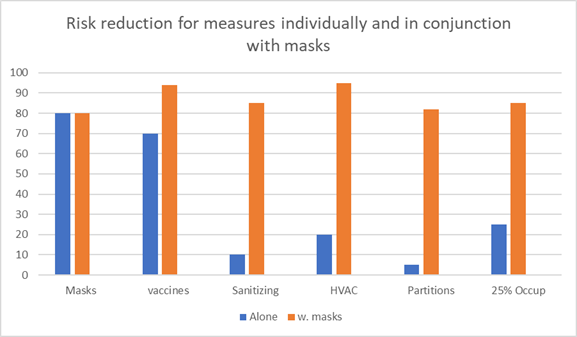
If everyone were vaccinated there is the
potential for a 94% risk reduction. Some
vaccines are only 60% efficient. With new
variants there may be ones developing that
resist all the present vaccines. It is therefore
reasonable to assess a risk reduction of 70%.
Sanitizing as a standalone measure provides low
risk reduction. If the transmitter is wearing an
effective mask there will be very little COVID
reaching surfaces. Since the virus acts like
perfume partitions are not effective as a stand
alone measure and are even less effective if
everyone is in tight fitting masks.
The exception would be dining areas where people
take off their masks. Partitions can help to
direct air away from the potential recipient.
But this is only where the HVAC and air filters
are properly designed.
HVAC can play a role in making needed
reductions.
It would be very costly to provide 100 fpm HEPA
filtered air from the ceilings down past all
occupants and then down through perforated
floors as in a pharmaceutical cleanroom. Instead
the HVAC can be working in tandem with effective
masks to supply MERV 16 filtered air in general
areas and HEPA filtered directed air in eating
areas, elevators, speaker podiums, locker rooms,
and other critical areas where masks cannot be
worn or where the virus load is considerably
higher than the average throughout the space.
If the HVAC is combined with effective masks and
wide spread vaccination there is a risk
reduction considerably higher than 99.0%.
Masks can be Made Available More Quickly Than
Vaccines
In wealthy countries tight fitting efficient
masks can be made quickly available. Vaccines
will take more time. By July 1 in wealthy
countries vaccines will cut the death rate by
30%. But in combination with masks the deathrate
will be reduced 65%.
By January 1, 2022, the vaccines alone
will account for a 60% drop in the deathrate.
But in combination with masks the
deathrate will drop by 96%.

Due to the ability to protect people quickly
with masks, they are the best weapon to fight
COVID.
As more people are vaccinated in wealthy
countries the combination of vaccines and masks
provides a 99% risk reduction.
Masks make a bigger difference in the poorer
countries. The risk reduction impact of vaccines
will be very low in 2021. It will reach 20% in
early 2022 and rise only to 70% by January 2024.
It will take longer to ramp up to supply masks
to poorer countries. But by January 2022
vaccines alone will only create a 25% risk
reduction whereas compared to over 50% for the
mask, vaccine combination.

This assumes a cautious approach by mask makers.
They do not scale up to provide all the masks
which are needed initially. But as vaccines take
on a bigger role in the wealthy countries, the
mask makers divert production to the poorer
countries.
Many more lives will be saved if the wealthy
nations subsidize mask programs in the poorer
countries. In this case the masks would be the
primary weapon for risk reduction the next 12
months. Epidemiologists point out that the
wealthy nations can justify subsidies to the
poorer nations just on economic grounds.
This approach based on risk reduction does not
address quantitative risk. Herd immunity will be
achieved by a combination of masks and vaccines
or even just by masks. The experts talk about
herd immunity being when 70 to 80% of the people
are immune.
With tight fitting masks this equivalent
is achievable
easily. We have quoted experts predicting
that the pandemic would be over in four weeks if
everyone wore a tight fitting efficient mask.
Important Findings on Mask use by PatientKnowhow
Devabhaktuni Srikrishna founder of
PatientKnowhow will be reporting on his recent
survey to
determine what masks
are being worn by the public and when do
they use them. Here are some of the findings.
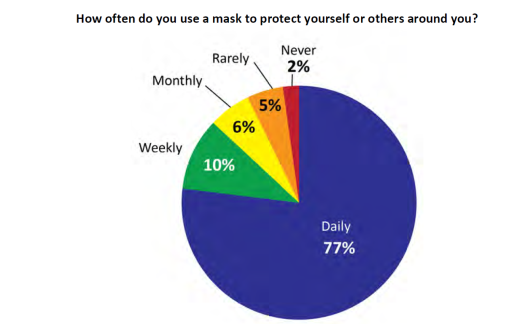
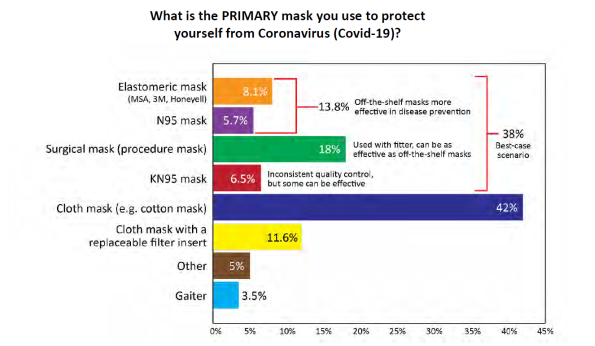
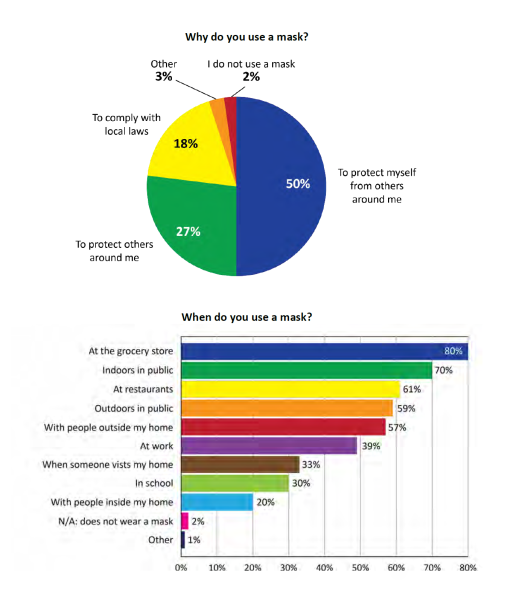
This survey is very helpful in laying out the
challenge ahead. Making the masks available is
just one step. Guiding the purchaser to buy the
right mask and then making sure he wears it
properly and in appropriate settings are both
equally important.
The full text is found at
http://www.mcilvainecompany.com/PDF/maskusagestudy.pdf
Two Percent Gap Can Cause Fifty Percent of the
Air to Circumvent the Media
FFP2 masks are the most recommended against
coronavirus, as
they protect others if you are infected and also
prevent you from contracting the virus if used
correctly. However, not knowing how to put them
on properly can lead to some problems.
The latter is what a world expert on aerosol
transmission José Luis Jiménez, a Spanish
scientist who works as a professor at the
University of Colorado (United States), warns
against. Through a thread on his Twitter
account, he has explained the dangers of not
fitting the FFP2 mask correctly to the face:
The ADJUSTMENT is a very big problem for the use
of masks for the general population. By holes
that seem small to us passes half of unfiltered
air. In this video (U Delft) three masks are
seen, the N95 and surgical are poorly adjusted
and have many leaks pic.twitter.com/UmgpFkybAd-
Jose-Luis Jimenez (@jljcolorado) February
1, 2021
"Through gaps that seem small to us, half of the
air passes unfiltered," warns the expert,
referring to the fact that aerosols can spread
through the environment if the FFP2 is not
properly placed. This
could lead to new infections even when wearing
the mask.
Jiménez explains that a 2% gap is enough for 50%
of the unfiltered air to escape. And this does
not only occur with FFP2 masks but can occur
with any type of mask.
Fernando Simón points out which masks are the
best for self-protection from COVID-19.
In his Twitter thread, the expert asks the
population to look for the best possible fit
when putting on the mask: "You have to work
quite hard and adjust the nose portion very well
so that it's really sealed." He also comments
that intensive education campaigns are needed to
teach people how to put the mask on properly.
"If they are worn badly, because of their shape,
they can create more of a gap than good fabric
masks, and in the end they work worse," says
Jiménez, referring to FFP2 masks and their
design, which, despite being safer, presents
difficulties for a correct fit.
Finally, the Spanish scientist asks that in the
future masks that are just as effective but
easier to fit be manufactured and
distributed free of charge among the
population: "It
would have a much lower cost than lockdowns,
health expenses, closing bars and restaurants,
general damage to the economy, etc."
Read the original
article on Business
Insider España.
Copyright 2021.
Comfort Clip Designed to Provide Optimal Mask
Fit
The Comfort
Clip for
Face Masks is an innovation by PACIFIC PPE that
builds upon the USA's National Institutes of
Health's clinically tested and open sourced Surgical
Mask Tension Release Band for Ear Comfort &
Extended Uses (Davis
Becker, April 1, 2020). Harnessing geometric
curvature and material-flex, the Comfort
Clip is
designed to provide an optimal fit for all head
shapes and comes in Small, Medium and Large sizes
(Extra Large Comfort Clip Coming
Soon).
